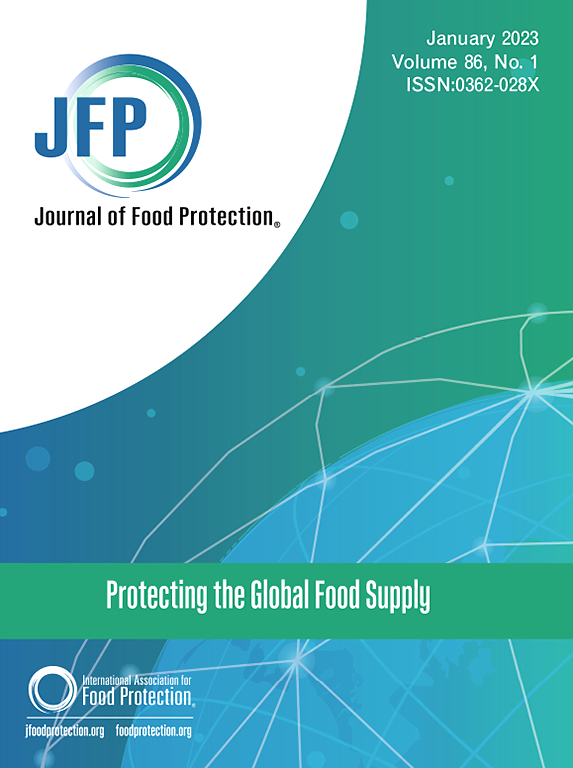A Longitudinal Study on Campylobacter spp. in an Integrated Broiler Complex in the Southeast Region of the United States: Prevalence and Phylogenetic Analysis
IF 2.1
4区 农林科学
Q3 BIOTECHNOLOGY & APPLIED MICROBIOLOGY
引用次数: 0
Abstract
Poultry meat products are considered the major contributors to Campylobacteriosis in humans. The objective of this study was to determine the prevalence status, critical entry points, and movement patterns of Campylobacter spp. along different stages of an integrated broiler complex. To isolate bacteria and perform phylogenetic analysis, a total of 790 environmental samples were collected from 38 production houses, a hatchery, 6 transport trucks, and a processing plant of a commercial broiler complex. Odds ratio and 95% confidence intervals were compared among different stages and sample types (α = 0.05). Altogether 17% (137/790) of samples and 61% (23/38) of production houses were positive for Campylobacter spp. Similarly, 34% (46/135) of samples were identified as Campylobacter jejuni (C. jejuni), and 61% (83/135) were identified as Campylobacter coli (C. coli). The odds of Campylobacter spp. detection in broiler farms’ surroundings were 4 times (1.88–8.26; 95% CLs) more likely as compared to parent pullets and breeder farms’ surroundings (p = 0.0004). Similarly, among different sample types, the odds of Campylobacter spp. detection in boot swabs and sponge-stick swabs were more likely as compared to fly paper samples (p ≤ 0.0024). In addition, the odds of Campylobacter spp. detection in postpick whole carcass rinses were 4 times (1.99–7.59; 95% CLs) more likely as compared to postchill carcass rinses (p = 0.0004). The phylogeny results of both C. jejuni and C. coli indicate multiple critical entry points of bacterial strains along the chain and suggest the possibility of transmission of Campylobacter spp. from broiler grow-out flocks through transport and to final raw products (29%) in the processing plant. The results indicate potential risks of foodborne infections in consumers from ingestion of contaminated raw or undercooked poultry meat. Therefore, a comprehensive control strategy may be essential to reduce or eliminate Campylobacter spp. or other zoonotic pathogens from the poultry food chain.
美国东南地区综合肉鸡群弯曲杆菌的纵向研究:流行率和系统发育分析。
禽肉产品被认为是人类弯曲杆菌病的主要贡献者。本研究的目的是确定弯曲杆菌在一个综合肉鸡群不同阶段的流行状况、关键入口点和运动模式。为了分离细菌并进行系统发育分析,从38个生产房、一个孵化场、6辆运输卡车和一个商业肉鸡综合体的加工厂共收集了790份环境样本。不同阶段、不同样本类型间的比值比和95%置信区间比较(α= 0.05)。17%(137/790)的样品和61%(23/38)的生产车间检测出弯曲杆菌,34%(46/135)的样品检测出空肠弯曲杆菌(C. jejuni), 61%(83/135)的样品检测出大肠弯曲杆菌(C. coli)。肉鸡养殖场环境中弯曲杆菌的检出率为4倍(1.88 ~ 8.26;95% CLs)与母雏和养殖场环境相比更有可能(p=0.0004)。同样,在不同的样本类型中,靴子拭子和海绵棒拭子检测弯曲杆菌的几率高于蝇纸样本(p≤0.0024)。此外,采后全尸冲洗中弯曲杆菌的检出率为4倍(1.99 ~ 7.59;95% CLs)与冷藏后的胴体冲洗相比更有可能(p=0.0004)。空肠C.和大肠C.的系统发育结果表明,细菌菌株沿着这条链存在多个关键入口点,并表明弯曲杆菌可能通过运输从肉鸡生长群传播到加工厂的最终原料产品(29%)。结果表明,消费者因摄入受污染的生禽肉或未煮熟的禽肉而有食源性感染的潜在风险。因此,一个全面的控制策略可能是必要的,以减少或消除弯曲杆菌属或其他人畜共患病原体从家禽食物链。
本文章由计算机程序翻译,如有差异,请以英文原文为准。
求助全文
约1分钟内获得全文
求助全文
来源期刊

Journal of food protection
工程技术-生物工程与应用微生物
CiteScore
4.20
自引率
5.00%
发文量
296
审稿时长
2.5 months
期刊介绍:
The Journal of Food Protection® (JFP) is an international, monthly scientific journal in the English language published by the International Association for Food Protection (IAFP). JFP publishes research and review articles on all aspects of food protection and safety. Major emphases of JFP are placed on studies dealing with:
Tracking, detecting (including traditional, molecular, and real-time), inactivating, and controlling food-related hazards, including microorganisms (including antibiotic resistance), microbial (mycotoxins, seafood toxins) and non-microbial toxins (heavy metals, pesticides, veterinary drug residues, migrants from food packaging, and processing contaminants), allergens and pests (insects, rodents) in human food, pet food and animal feed throughout the food chain;
Microbiological food quality and traditional/novel methods to assay microbiological food quality;
Prevention of food-related hazards and food spoilage through food preservatives and thermal/non-thermal processes, including process validation;
Food fermentations and food-related probiotics;
Safe food handling practices during pre-harvest, harvest, post-harvest, distribution and consumption, including food safety education for retailers, foodservice, and consumers;
Risk assessments for food-related hazards;
Economic impact of food-related hazards, foodborne illness, food loss, food spoilage, and adulterated foods;
Food fraud, food authentication, food defense, and foodborne disease outbreak investigations.
 求助内容:
求助内容: 应助结果提醒方式:
应助结果提醒方式:


